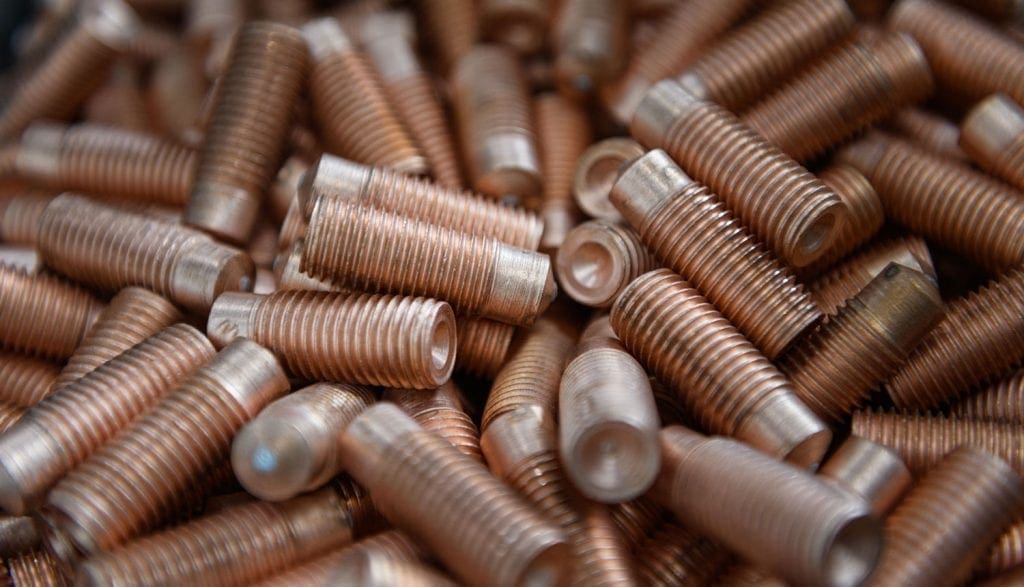Bright Nickel Plating for an electrical safety systems manufacturer
Service: Zinc Plating
End user
Electrical safety systems manufacturer.
Component description
A small fragile electrical terminal pressed from brass. Mounted in a smoke detector it is an integral part of the circuit which triggers the alarm if smoke is present.
Coating requirement
An electrically conductive coating which will not tarnish or degrade over time. Due to the delicate nature of the profile of the pressings, careful handling and processing is essential to ensure no parts are bent or deformed.
Solution supplied
Bespoke plating barrels are used which are designed to ensure the components cannot get trapped in the drainage holes or internal joints of the barrel and so eliminating the possibility of parts bending while plating.
Similarly by investing in variable speed centrifugal driers we are able to slowly and gently increase the drier spin speed as well as slowly reduce the spin to standstill.
Care is taken to control the deposit thickness to ensure that the nickel coating is ductile so that it does not crack during assembly into the final product.

View Our Services

Zinc Nickel Plating
Our Zinc Nickel Plating services provide superior corrosion resistance and meet the rigorous requirements of major automotive specifications. This alloy finish is ideal for components exposed to harsh conditions, including marine environments and high-temperature applications. EC Williams has extensive experience in delivering zinc nickel plating to automotive and aerospace industries.

Copper Plating
Copper Plating is often used as an undercoat for tin, silver, or nickel plating, enhancing corrosion resistance and providing a strong base for additional coatings. It can also be used as a finish in its own right, offering conductivity and aesthetic appeal. Whether for decorative or functional purposes, our barrel and rack plating facilities ensure a uniform and high-quality finish.

Nickel Plating
Nickel Plating provides a highly durable finish with excellent corrosion resistance and wear properties. At EC Williams, we offer barrel Nickel Plating for a variety of substrates, including steel, brass, and zinc die-cast components. Nickel is frequently used in applications requiring both aesthetic and functional performance, such as electrical components and fasteners.

Tin Plating Services at EC Williams
At EC Williams, we provide both bright and matt tin plating options, depending on your application. Tin plating offers excellent corrosion resistance, solderability, and electrical conductivity, making it ideal for use in electronics, power distribution, and automotive components. Our jig and barrel plating facilities can accommodate projects of various sizes, ensuring flexibility and precision.

Zinc Plating
Zinc Plating is one of the most versatile electroplating finishes available. At EC Williams, we provide zinc plating with a range of passivates, including clear, yellow, black, and olive drab, to suit various applications. Zinc plating offers excellent corrosion resistance, making it ideal for fasteners, brackets, and automotive components.

JS500 Zinc Plating Services
Our JS500 zinc plating offers enhanced corrosion resistance by applying a zinc-plated finish with a silicate sealant. This process meets the requirements of both the ELV and RoHS directives, making it a popular choice in the automotive industry for components that need to withstand harsh environmental conditions.

Trivalent Yellow Passivate
This Trivalent Yellow Passivation process enhances the corrosion resistance of zinc-plated parts. It is chromium(VI)-free, making it an environmentally friendly option that complies with modern safety standards, including RoHS directives. This finish is ideal for automotive and industrial applications requiring reliable corrosion protection without hazardous substances.

Stainless Steel Coatings
Our Stainless Steel Coating services include passivation, which enhances both the appearance and corrosion resistance of stainless steel parts. Passivation removes contaminants from the surface of the steel, forming a protective oxide layer that prevents rust and improves longevity in aggressive environments.
